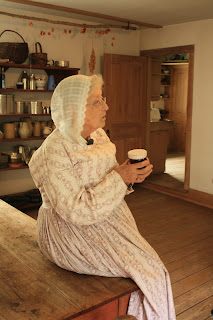In 1844 Sylvanus and Betsey Wade were the first to settle Greenbush and chose the area with the specific purpose of establishing a village halfway between Sheboygan and Fond du Lac along a well-used stagecoach trail. Sylvanus Wade sold most of his land to enterprising settlers. They, like him, were willing to stake their futures on the little community. The Wades kept a tavern in their log house and as the years passed and business grew, they twice expanded the structure. They built the inn in 1859 and it was the scene of cotillions, business meetings, political caucuses and circuit court sessions. The taproom buzzed with debates of issues as mundane as last year's crops and as heady as secession and the abolition of slavery.
The property was kept in the family until 1941, and when the new owner was unable to keep up with restorations The Kohler family and the Kohler Foundation purchased Wade House in 1950 and began a top-to-bottom restoration. It was deeded to the Wisconsin Historical Society in 1953. As usual, I listened while wandering around with my camera and I found the soft light from the overcast day coming in the old glass wonderful to work with.
The others on our tour were especially amazed at the wood burning cook stove in the kitchen and how people could actually coax meals out of such a hard to keep regulated source of heat. Those of us who have had the experience of using or watching others use them in real life know that like anything else it's just a matter of knowing your tools! Some of my fondest childhood memories are of my grandmother's wood burning stove in Newfoundland and the bread she baked in it. I might be killed for including the next two photos, but what's life without a little risk taking?
Some of Nan's bread would have gone great with that jam another volunteer made from the garden in the Wade House kitchen over the weekend! If I visit again I'll have to make sure to come on the weekend to catch one of their demonstrations.
Also on the property are the carriage collection of Wesley W. Jung, grandson of a Sheboygan carriage maker, a blacksmith shop, and the rebuilt Herrling Sawmill which had stood in Greenbush throughout the second half of the 19th century on its original site. I'll get to those in the next post!






We may be the last generation to truly remember seeing others use cookstoves. I remember an aunt who lived in the mountains of upper east Tennessee making the best food EVER on a cookstove. They eventually got electricity, but there were some things she never stopped making on the cookstove! It just tasted better, didn't it?
ReplyDeleteWe slapped the bread directly onto the top of the stove. BEST TOAST EVER!
Delete